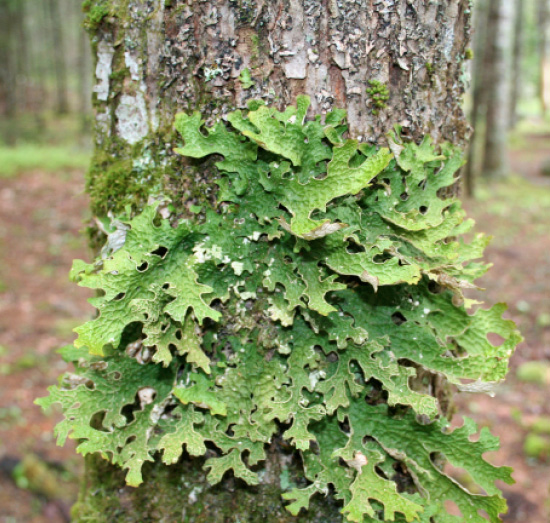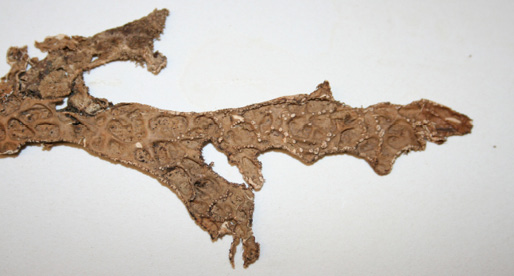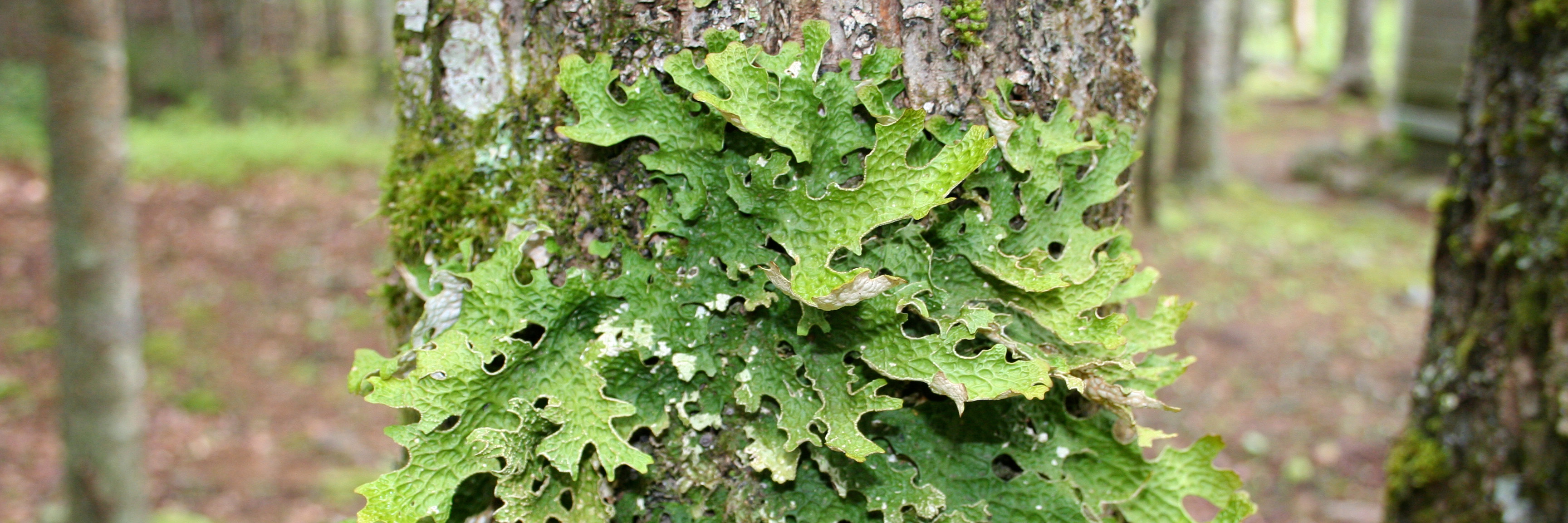Lichens are a lovely part of Iowa’s native biodiversity, but are easily overlooked and often misunderstood. When noticed by the casual observer, lichens are often thought be a type of “moss.” True mosses are actually a type of plant, but lichens are not plants at all. Lichens are fungi that have an intimate symbiotic relationship with a photosynthetic organism, either a green alga or a cyanobacterium. 1 The fungus is almost always an “ascomycete” (“sac fungus”) the same group of fungi to which morels and truffles belong. Recently, we have learned that many lichens are more complex than had been previously understood. and they can have additional fungal components. 2 Lichens play various roles in ecosystems. Many lichens are used for food and shelter by numerous species of smaller insects and other arthropods. Some birds use lichens as nest material. Those lichens with cyanobacteria can fix nitrogen from the air, thereby increasing the amount of nitrogen available to plants in their local ecosystem.
Lichens in Iowa can be found on a wide range of substrates, including soil, rocks, wood, and even human-made materials such as concrete, plastic, rubber, and metal. The most common substrate for Iowa lichens is probably bark (Fig. 1). Taking a close look at the bark of virtually any tree in Iowa is likely to reveal the presence of one type—and usually more—of lichen. Physcia stellaris (Fig. 1), and the very similar Physcia aipolia are amongst the most common “foliose” (i.e., leaf-like) bark lichens in Iowa. Candelaria concolor (Fig. 1) is also commonly found on the bark of trees in Iowa. Teloschistes chrysophthalmus (Fig. 1) is a lovely, but much less common, “fruticose” (i.e., shrub-like) lichen found on the bark of Iowa trees. Overall, a surprising diversity of lichens has been recorded in the state. There have been 478 distinct lichens recorded in Iowa, 3 which is almost 10 times more than the number of mammal species currently found in the state and about the same as the number of bird species.

Figure 1. Lichens growing on the bark of a wild plum (Prunus americana) branch. The orange lichen is Teloschistes chrysophthalmus (“golden eye lichen”), the gray lichen is Physcia stellaris, and the yellow lichen is Candelaria concolor. Image taken in Adair County, Iowa in 2020. All photos courtesy of James Colbert
Although nearly 500 different types of lichens have been recorded here, at one time or another, it seems fair to ask whether all of these lichens are here now and whether settlement by Europeans had any effect. To put the answer to this question in its proper context, it is important to examine the effect of European settlement on Iowa’s biodiversity as a whole. Two-hundred years ago, in 1823 prior to European settlement, Iowa was a very different place. The Lewis and Clark expedition had passed by the state’s western border while headed upstream on the Missouri River only 19 years previously. The first official settlers of European descent wouldn’t arrive for another decade, though indigenous peoples such as the Ioway and the Dakota had long been thriving in the region.
Iowa in 1823 was also very different from today with respect to its non-human biodiversity. 4 Most of the state was covered by millions of acres of fire-dependent tallgrass prairie. Large portions of eastern Iowa were part of the western border of the great eastern temperate deciduous forest. Much of north-central Iowa was dotted with pothole lakes and innumerable wetlands of every size. The land was teeming with animals. 5 There were herds of bison and elk. Large predators roamed the state, including mountain lions, gray wolves, and black bears. The rivers and streams were home to large populations of beavers, river otters, and many less obvious species, including a wide array of freshwater mussel species. 7 The deciduous forests of eastern Iowa had plentiful turkeys, ruffed grouse, and phenomenal numbers of passenger pigeons. Prairie chickens were found throughout the state, and during the fall and spring migrations many species of ducks and geese darkened the skies.
The populations of many species that were common in Iowa in 1823 have been dramatically reduced since then. Perhaps the most obvious would be any of the common tallgrass prairie plant species that once blanketed most of the state. These have been replaced in large part by corn, soybeans, and non-native pasture grasses. Remnant tallgrass prairie has been reduced to a tiny fraction of its former extent. Early on many of the larger and economically important animal species were extirpated from the state. There are no longer free-ranging reproducing populations of mountain lions, gray wolves, black bears, bison, or elk in Iowa. The last known wild elk in Iowa was seen in 1871—a mere 25 years after Iowa achieved statehood. Other species, including river otters and turkeys, were extirpated from the state, but subsequently reintroduced by the Iowa Department of Natural Resources, and currently these species have healthy populations throughout the state. The prairie chicken was also extirpated and has been reintroduced, but the lack of suitable habitat allows only a small resident population, primarily at Kellerton Grassland in Ringgold County. At least one native Iowa species, the passenger pigeon, will never return. It was driven to extinction by overharvesting and habitat loss due to the activities of settlers of European descent, with the last known individual dying in 1914.
Our knowledge of native Iowa species that have been dramatically reduced in population size, extirpated, or driven to extinction over the last two centuries depends on the historical records that allow us to know what species were present in, for example, 1823. Unfortunately, those records typically reflect only the most common, the largest, and/or the most economically important species. Smaller native species with no obvious economic importance were given very little attention. Consequently, little information is available from the early years of European settlement of Iowa, so we know very little about these native species and are dependent on records kept by early Iowa residents who were self-styled naturalists and who paid attention to some of the state’s less obvious native species. Even with these sources taken into account, it wasn’t until the latter half of the 1800s that these species began to be recorded and preserved. It’s impossible to know what diversity might have been diminished or lost in these early years.
Lichens certainly fit into the category of “small species with no obvious economic importance,” and it’s highly unlikely they would have been considered noteworthy by early Iowa settlers. The first lichen recorded in Iowa was collected in 1870 by Dr. Charles Bessey who, at the time, was a faculty member at the institution destined to become Iowa State University. The lichen was Parmotrema crinitum, and the specimen currently resides in the University of Wisconsin-Madison Herbarium.7 This lichen likely still persists in Iowa as a recent population was recorded in 2013. 8 That is not, however, necessarily the case for all of the other lichens recorded for Iowa. By our estimate, at least 33 of Iowa’s recorded lichens are currently quite rare in— or potentially extirpated from—Iowa. 9 It is also possible, perhaps even likely, that there are other native lichens that may have been extirpated from Iowa—some having been lost before anyone recognized that they were ever present here.
It is impossible to know with certainty that a lichen has been extirpated from a region in which it was previously known. However, extensive searching of suitable habitat without finding a population of a particular lichen provides strong evidence for extirpation.

Figure 2: Lobaria pulmonaria growing on the bark of a sugar maple (Acer saccharum) tree. Image taken in the state of Maine in 2011. The same species grows in Iowa.
The best example of a native Iowa lichen that has likely been lost is Lobaria pulmonaria (Figure 2). This lichen is a rather large and prominent bright green foliose lichen that grows on tree bark. It is easy to find and identify. Still, it has been recorded only four times in Iowa, between 1894 and 1901, in three northeast Iowa counties (Clayton, Dubuque, and Fayette), where it was collected by two of Iowa’s early naturalists—Dr. Bruce Fink and Dr. Bohumil Shimek. One of Fink’s Lobaria pulmonaria specimens resides in the Iowa State University Ada Hayden Herbarium (Fig. 3). Without these scientists’ efforts we might never have known Lobaria pulmonaria was native to Iowa. Given its size and prominence it seems likely that this lichen was rare in the late 1800s. Its abundance 200 years ago in 1823 is impossible to determine. An extensive search (a total of roughly 92 miles of search effort 10, 11) in suitable habitat was carried out in Dubuque and Clayton Counties, as well as in neighboring Allamakee, Delaware, and Winneshiek Counties between 2008 and 2017. No populations of this native Iowa lichen were discovered. Lobaria pulmonaria is very likely a lichen that is no longer part of Iowa’s native biodiversity. Lobaria pulmonaria is known to be an old growth forest lichen that is also sensitive to air pollution. 12 Due to human activities, Iowa has very little, if any, remaining old growth forest, and the state has air quality issues of various kinds as well.

Figure 3: Specimen of Lobaria pulmonaria collected by Dr. Bruce Fink in 1894. From the Ada Hayden Herbarium Lichen Collection, Accession # 25303
Some might argue that the extirpation of Lobaria pulmonaria from Iowa is no great loss. It is, after all, quite abundant in some other parts of the world, including northern Minnesota. One could get in a vehicle, drive about 500 miles north, find suitable habitat, and have a reasonable chance of seeing Lobaria pulmonaria in the wild. Still, it is sad to have a lovely lichen that was formerly present in “our own backyard” disappear, very likely as a result of our own activities. Perhaps we should consider reintroducing Lobaria pulmonaria to Iowa. It worked for turkeys and river otters.
1 Brodo, I.M., S.D. Sharnoff, S. Sharnoff. 2001. Lichens of North America. Yale University Press, New Haven, Connecticut.
2 Spribille, T., Tuovinen, V., Resl, P., Vanderpool, D., Wolinski, H., Aime, M. C., and McCutcheon, J. P. 2016. Basidiomycete yeasts in the cortex of ascomycete macrolichens. Science, 353, 488-492.
3 Thompson, K.M. and J.T. Colbert. 2020. Lichens of Iowa’s White Pine Hollow State Preserve. Evansia 37: 31-49.
4 Iowa Department of Natural Resources. 2000. Iowa - Portrait of the Land. Des Moines, Iowa.
5 Dinsmore, J. 1994. A Country So Full of Game. The story of wildlife in Iowa. University of Iowa Press, Iowa City, Iowa.
6 Poole, K. E. and J. A. Downing. 2004. Relationship of declining mussel biodiversity to stream-reach and watershed characteristics in an agricultural landscape. J. North American Benthological Society 23:114-125.
7 Consortium of North American Lichen Herbaria. 2023. https://lichenportal.org/portal/. Accessed February 22, 2023.
8 Podaril, A. L. and J.T. Colbert. 2015. Lichen diversity in southeast Iowa. Opuscula Philolichenum 14: 121-138.
9 ibid.
10 Colbert, J.T. 2011. Current status of lichen diversity in Iowa. Proceedings of the Iowa Academy of Science 118: 16-23.
11 Thompson and Colbert, 2020.
12 Brodo et al., 2001


